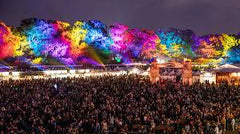The Evolution of Rave and Festival Fashion Over the Years
Posted by Cosplay Moon on
The Evolution of Rave and Festival Fashion Over the Years

-
Introduction
- Setting the stage for the evolution of rave and festival fashion.
-
The Birth of Rave Culture
- Exploring the origins of rave culture in the late 1980s.
- Discussing the fashion choices that symbolized the rebellious spirit of early ravers.
-
The 90s Rave Aesthetic
- Examining how rave culture and fashion gained mainstream popularity in the 1990s.
- Highlighting the distinctive elements of the 90s rave look, including neon colors and iconic accessories.
-
The Flower Power and Bohemian Vibes of the 60s and 70s
- Tracing the influence of the 1960s and 70s counterculture on festival fashion.
- Discussing the significance of tie-dye, fringe, and flower crowns in this era.
-
The Festival Fashion Renaissance of the 2000s
- Exploring the resurgence of festival culture in the 2000s.
- Detailing the emergence of boho chic and the individualistic approach to festival attire.
-
Modern Festival Fashion: Eclectic and Inclusive
- Analyzing contemporary festival fashion trends that emphasize diversity and sustainability.
- Showcasing the wide range of styles and accessories embraced by festivalgoers today.
-
Q&A: Your Burning Questions Answered
- Providing answers to common questions about the evolution of festival fashion.
- Addressing inquiries related to the historical context and current trends.
-
Conclusion: The Ever-Changing Canvas of Expression
- Summarizing the dynamic evolution of rave and festival fashion.
- Reflecting on the enduring significance of fashion as a means of self-expression.

The Birth of Rave Culture:
The late 1980s marked the birth of rave culture, an underground movement driven by electronic dance music (EDM) and the desire to break free from societal norms. The fashion of early ravers was a direct reflection of this rebellion against the mainstream. Ravers embraced bold, colorful clothing, often featuring neon hues that glowed under blacklights. Oversized t-shirts, baggy pants, and smiley face motifs became iconic elements of the rave look. Accessories like pacifiers, visors, and glow sticks were also prevalent. The attire was not just about fashion but also a statement of unity, celebrating the freedom of expression found in the underground dance scene.
The 90s Rave Aesthetic:
The 1990s saw the rave culture explode in popularity, spreading from underground clubs to mainstream music festivals. This era's rave fashion became more mainstream as well, incorporating elements like chunky platform shoes, furry boots, and UFO pants. The "candy raver" look emerged, featuring colorful beaded bracelets and necklaces. Phat pants and baggy attire were still dominant, with clothing brands like JNCO and Kikwear gaining cult followings. The smiley face and "PLUR" (Peace, Love, Unity, Respect) symbols continued to symbolize the ethos of the rave community.
The Flower Power and Bohemian Vibes of the 60s and 70s:
While rave culture was taking shape in the late 20th century, festival fashion took inspiration from the counterculture movements of the 1960s and 70s. This influence was particularly evident at iconic festivals like Woodstock. Festivalgoers embraced tie-dye, fringed vests, bell-bottoms, and flower crowns. The fashion of this era celebrated free-spiritedness and individuality, mirroring the anti-establishment sentiments of the time. It was a fusion of fashion and ideology, emphasizing peace, love, and unity.
The Festival Fashion Renaissance of the 2000s:
As music festivals gained popularity in the 2000s, festival fashion underwent a renaissance. Boho chic became a dominant trend, with attendees donning flowing maxi dresses, floral headbands, and fringe vests. Crop tops, high-waisted shorts, and tribal prints also became festival staples. This era emphasized self-expression and individuality, encouraging festivalgoers to curate unique and eclectic outfits.
Modern Festival Fashion: Eclectic and Inclusive:
Today's festival fashion is a testament to the diversity of styles and influences within the global festival community. Sustainability has taken center stage, with many festivalgoers and designers opting for eco-friendly materials and ethical production practices. Inclusivity is a key theme, celebrating diversity in body types, gender expression, and personal style. Festival fashion is no longer confined to a particular aesthetic; it's a celebration of self-expression. You'll find festivalgoers rocking anything from steampunk-inspired ensembles to futuristic cyberpunk aesthetics. Accessories play a crucial role, with body jewelry, holographic fabrics, and statement headwear adding a touch of individuality to each look.
Q&A: Your Burning Questions Answered
Q: What inspired the colorful and bold fashion of early rave culture? A: Early rave fashion was inspired by a desire to break free from societal norms. The bold, colorful look represented the optimism and unity of the underground rave scene.
Q: How did festival fashion evolve to embrace sustainability? A: The shift towards sustainable festival fashion was driven by environmental awareness. Designers and festivalgoers began to prioritize eco-friendly materials and ethical production practices.
Q: What are the key elements of today's festival fashion? A: Today's festival fashion is eclectic and diverse. Key elements include sustainability, inclusivity, and the freedom to mix and match styles. Accessories like body jewelry, holographic fabrics, and statement headwear are also popular.
Conclusion: The Ever-Changing Canvas of Expression Rave and festival fashion has come a long way, evolving with the times and reflecting the values and aspirations of each era. From the rebellious spirit of early raves
Conclusion: The Ever-Changing Canvas of Expression:
In conclusion, the evolution of rave and festival fashion is a testament to the power of fashion as a form of self-expression and cultural reflection. From the rebellious spirit of early raves to the inclusivity and sustainability of modern festival styles, festival fashion continues to be a canvas for creativity and individuality. As festivals continue to evolve, so too will the fashion, reflecting the values and aspirations of each new generation of festivalgoers. It's a celebration of unity, diversity, and the boundless possibilities of self-expression through clothing.

